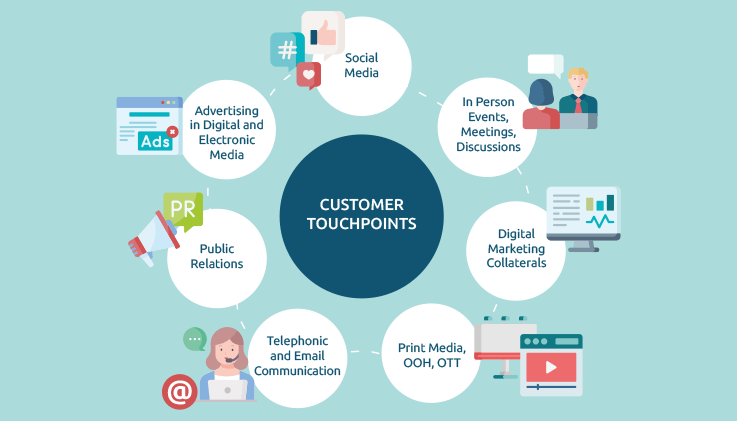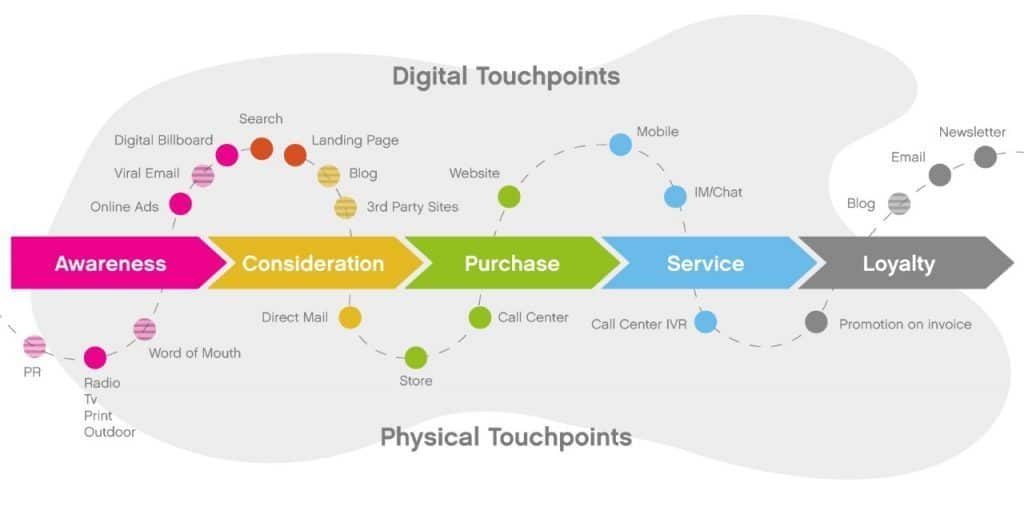Touchpoint in Marketing: How Do You Track Them?
When you go to a shop to buy an item, there are key moments, moments that make your purchase happen. There are small moments and there are big moments. Let’s say, for example, you need a shirt. You think of which store you want to visit and you go to that store. That is one key moment. You check out the collection and your eyes go to one particular shirt that catches your attention. That is another moment. Then you try it on and you think the shirt fits well and looks good on you. You set your mind on it and that is the final big moment before the purchase happens.
B2B businesses go through a similar journey making purchases online. Except, this time, the journey is long, has complexities, multiple big and small moments, and different decision-makers. These moments that lead to purchase are what we call “touchpoints” in marketing. In this article, we will discuss in detail, what touchpoints are, and how they can be tracked to help you acquire customers more efficiently.

Image Source: ThinkOwl
What are Marketing Touchpoints?
A touchpoint is an interaction between your business and your customer. Visiting your website, signing up, or making an enquiry are all touchpoints. A lead would go through several touchpoints before becoming a customer. Every touchpoint contributes to the purchase in some ways but some touchpoints are more important than others. For example, visiting the pricing page is a more impactful touchpoint than visiting any other page of lower importance. In B2B, the touchpoints happen across different channels over a longer period of time. Tracking and mapping touchpoints efficiently can help you in understanding customer motivation, qualifying leads, showing effective content, generate analytical reports, and attribute marketing actions to revenue.

Image Source: dogoodthings.co.nz
Different Marketing Touchpoints in B2B
Touchpoints happen through all channels you engage your customers on. It would include both online and offline touchpoints depending on how your business operates. Since most of our readers sell digitally, we would cover online touchpoints in this article.
Website Pages
In digital marketing, your website is where most of the magic happens and you have full control over every touchpoint. Your primary website items like landing pages, the pricing page, customer showcase pages, and other pages play a crucial role in influencing the customer. These are crucial touchpoints.
Forms
Customers interact with forms when they sign up and/or decide to share their contact information. Without customers filling up the forms, you have no information. This is one of the most crucial touchpoints in the entire customer journey. When a form is filled, a lead is generated and you have control over how to take the deal further.
Blog
Blogs are a common medium to acquire website visitors, some of whom later, convert into customers. Many businesses, especially the ones focused on inbound marketing, use blog posts to show up to new prospects. When potential customers find your blog when searching for new information, this usually becomes their first touchpoint.
Social media for customer engagement has been growing at a rapid pace. This is a platform that can be used to introduce your product or services to a brand new lead or engage your existing leads. If social media is a key part of your strategy, leads and customers would engage with your brand and content and have several touchpoints both before and after the purchase. Tracking social media touchpoints is slightly tricky as the activities happen outside of your website. But, this can be mitigated using UTM parameters and appropriate tools.
Emails
Emails and newsletters are crucial ways to nurture and engage with customers. Every email that a customer engages with is a potential touchpoint. This is especially the case if you are using drip campaigns to slowly nurture or onboard your leads. Any kind of email, be it sales emails or marketing newsletters, or product emails, can be used as touchpoints.
These are the various channels your visitors use to engage with you throughout their journey. Depending on how you operate there can be several other touchpoints like forums, calls, etc.
Understanding Key Touchpoints and Mapping Them into The Customer Journey
In the previous section, we tried to break down different touchpoint channels. Let’s now understand which touchpoints are actually key and learn how you can map them throughout the customer journey.
Mapping customer journey is crucial to get a grip of your sales and marketing operations. It helps you optimize and control the entire funnel, personalize experiences as needed, qualify and prioritize leads based on touchpoint interactions, and create different journeys for different buyer personas.
Awareness Touchpoints
In this phase, the customer has his/her very first touchpoints with your business. They might have found you from search or they might have found you on social. The first touchpoints introduce the customer to your brand and as such, tracking them helps you connect ROI to marketing efforts and understand the initial motivation of the lead.
The awareness touchpoints can be a part of your website, social media, or events. Your customer journey map starts with the interactions in the awareness stage. Here are a few examples:
- The customer searches for a keyword and finds your blog post through search. He/she decides to stay and check out your product.
- The customer becomes familiar with your business after he/she sees an ad campaign that you are running on LinkedIn.
- The customer becomes familiar with your brand after they receive an email from you.
Consideration
At this stage, the customer is considering your products and evaluating everything. If you have a self-service model, most touchpoints are going to happen on your website. Customers would engage with the content on your website, view your landing pages, talk to live chat, interact with your forms, and also take several key actions. This basically means that page views, form submissions, live chat engagement, etc. are all part of the consideration stage. Here are examples of touchpoints in the consideration stage:
- Customer visits the pricing page.
- Customer contacts live chat to make an enquiry.
- Customer reads case studies.
- Customer signs up for free trial.
Decision/Purchase
At this stage, the customer takes the decision to purchase. This will be the ultimate touchpoint. There might be touchpoints prior to the purchase that help customers make this decision. And, tracking this touchpoint is crucial for last-touch attribution.
Here are some examples:
- Customer submits payment details and makes the upgrade.
- Customer upgrades to paid plan.
- Customer gets discount coupon on email, clicks the link (last-touchpoint) and purchases.
Key Challenges
Digital engagement and sales in B2B happen through multiple channels over a course of several weeks. As such, tracking the entire journey is not as straightforward as something like eCommerce sales and is prone to challenges. The more steps and platforms involved, the more challenging accurate tracking is. Let’s understand some of the common challenges.
The Complexity of Multi-Channel Tracking
As engagement happens across multiple channels, it is hard to keep everything under one roof. Your potential customers might be visiting from Google Search one day and visiting from a LinkedIn post another day. If all of these activities happen from the same device and browser, a good tracking tool will probably be able to stitch the sessions together. Otherwise, identity resolution of some sort would be required. It is also a good idea to use UTM tracking to understand cross-channel activities.
Activity from Multiple Devices
Sometimes buyers would navigate to your website from different devices or browsers. In that case, the cookie would be different and the sessions cannot be stitched together. This is more common for B2C than B2B customers because the latter usually browse from the same work environment. In any case, to solve this problem, some form of identity resolution is required. You can identify the company to stitch the data or ask for email address.
Urgency of Purchase
With so much happening, understanding the ‘customer-fit’ and the urgency of purchase of your leads is a challenge. This can be mitigated with proper tracking and then using the data for segmentation and lead scoring. The data can also be passed on to sales reps in real-time to help them prioritize buyers with more urgency.
Tracking Revived Interest
Many of your visitors or leads would end up not purchasing. But, there would be a handful of these bounced visitors who will come back after weeks or months. Maybe, when they checked out your product, their buying windows were not open. Or, they have a complex purchasing process. Without proper tracking, you would not be able to recognize leads with revived interest. This problem requires a tracking framework that tracks customer journeys across longer time periods.
Marketing Touchpoint Tracking With Salespanel
A marketing touchpoint tracking solution would ideally be able to connect and stitch as many cross-channel interactions as possible. No product can do this 100% accurately as anything happening outside of your website can be beyond your control. Regardless, UTM parameters, referrer data, and thorough website tracking can help you get the data you need. In this article, we would like to propose Salespanel as your tool of choice.
Salespanel utilizes UTM tracking, templates, and referrer data to identify the touchpoint of origin when leads visit from 3rd-party sources. On your website, it tracks pageviews, media consumption, duration of visits, etc. You can also set up custom events for touchpoints and the tool will start tracking it. These can be specific actions, button clicks, or media viewings (like watching testimonials) that are important to you.
All of this data is stitched together to provide you a 360-degree view of every potential customer. You can use the data for analytical purposes or to segment and score leads. The data can also be synced to your CRM in real-time to enlighten your sales reps about every touchpoint interaction and help them stay one step ahead. Have any questions? We would be happy to provide a free consultation. Contact us from our website.
Sell more, understand your customers’ journey for free!
Sales and Marketing teams spend millions of dollars to bring visitors to your website. But do you track your customer’s journey? Do you know who buys and why?
Around 8% of your website traffic will sign up on your lead forms. What happens to the other 92% of your traffic? Can you identify your visiting accounts? Can you engage and retarget your qualified visitors even if they are not identified?


